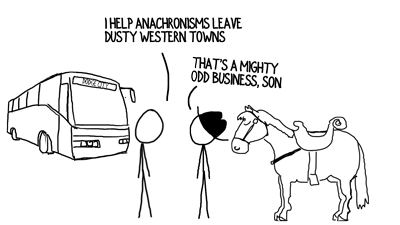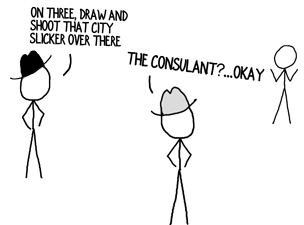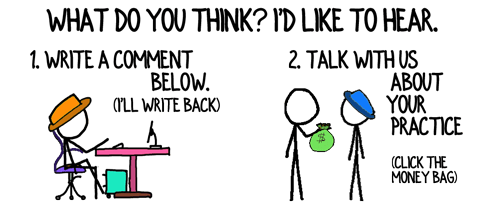There’s a gap in your marketing communication. A chasm. A gaping hole large enough to drive prospects through. On a bus. Yep, you’re losing out on a busload of prospects… but we’ll get to that in a moment.
You know that you have to meet your customers “where they are,” right? But where are they, and where are you? Let’s arrange your prospective clients along a spectrum of awareness:
- Blissfully Unaware – These folks don’t even know they’ve got a problem that’s dogging their heels.
- Aware of Symptoms – These prospects are experiencing some pain because the problem is rearing its ugly head.
- Aware of Problem – At this point prospects have determined “the” cause of their pain and realize they need to get outta Dodge.
- Aware of Solution – After intensive Googling, prospect have determined there’s bus service from Dodge to Sunny Beach.
- Aware of Your Solution – Prospects in this group are evaluating the ergonomics of the seats on your bus, the fare you charge and whether you show spaghetti Westerns en route.
Below is a scientific (looking) graph depicting how prospective clients are arrayed across the spectrum.
Meeting your customers where they are means talking in language that matches their stage of awareness. If you try highlighting the value of tickets on your air-conditioned getaway vehicle to folks who don’t even know they should be leaving town, you’re not going to get many takers.
Now, based on your marketing communication, where are you? There’s a good chance your websites, articles, speeches, books, blogs, and conversations place you firmly in the “talk about my solution” camp.
This is because most consultants suffer from problemica articulitis, a malady that renders them incapable of stating the problem they solve in clients’ language. I know this because I have asked literally thousands of consultants to tell me what problem they solve or symptoms they address, stated in the client’s language. Fewer than 5% respond with phrases similar to what you’d hear from a prospect at the Symptoms or Problem stage.
Ninety-five percent of consultants describe their offering or they pat themselves on the back while stressing the benefits they deliver. It sounds like, “We offer mid-process reigniter optimization that increases your total burn efficiency.” Okay, it doesn’t sound exactly like that. More like, “We develop marketing strategies that help you grow.” (Though that’s so generic, you’d have more luck talking about mid-process reigniters.)
That’s perfectly fine if all your communication is directed only toward people who are already aware of their symptoms, their problem and their preferred solution. However, most prospects are hanging out in the early stages of the awareness cycle, and your communication isn’t resonating with those folks because it’s not meeting them there they are.
As a result, too few prospects are purchasing your tickets and your bus is far emptier than it should be.
You can close your communication gap and drive more clients to your solution by employing language that speaks to prospects at each stage of awareness. Don’t rush to the sale. Your goal is simply to move the prospect to the next stage, then the next, then the next until buying your consulting services is as obvious as a ham sandwich. On a bus.
This means you should present different messages on your web pages, email blasts, blogs, articles and speeches depending on who you’re reaching with each medium and where they are.
The boxes below explains how to focus your messages:
Stage: Blissfully Unaware
Message Focus: Relationship Building and Diagnostics.
i.e.: Mention how delightful Dodge was in years past then point out that scrambling from barber-shop to saloon between gunfights is not how most people live.
Don’t Say: Do not talk about your solution at this stage.
Comment: Creating awareness can be rough sledding. Make your diagnostic easy to access and efficient to distribute.
Stage: Aware of Symptoms
Message Focus: Symptoms and Causes.
i.e: Sympathize with the harried lifestyle and suggest that loitering on a street popular with gunslingers might be the issue.
Don’t say: Talk lightly about solutions, if at all.
Comment: This is the ideal stage to capture prospects. They haven’t yet decided what the problem is, and you can guide them toward an understanding that meshes seamlessly with your solution.
Stage: Aware of Problem
Message Focus: Problems and Solutions.
i.e: Agree that, dagnabit, those rustlers are a dangerous bunch. Then present foot, horse and bus as viable options for getting outta Dodge.
Don’t say: This is where you start highlighting your advantages. Don’t waste time on awareness-building.
Comment: This can be a fruitful stage if your solution is a dead ringer for the problem or if you’re good at reframing. Prospects don’t stay at this stage long and, whether they’re right or not, few prospects will budge from their understanding of the problem.
Stage: Aware of Solutions
Message Focus: Solutions and Your Advantages.
i.e: You can concentrate wholly on the comfort, reliability and speed of your bus vs. the old grey mare or their tired, busted feet
Don’t say: No need to delve into problems and symptoms. Prospects at this stage want comparisons.
Comment: At this point, you’re either a fit or you’re headed for frustration. Trying to change a prospect’s mind is rarely worth the effort
Stage: Aware of Your solution
Message Focus: Value, Credibility and Other Deal Sealers.
i.e: Reassure them that in a matter of hours they’ll be lounging on a beach sipping cocktails, with tumbleweeds a fading memory.Press your advantages.
Don’t say: Now is not the time to go back to symptoms and root causes
Comment: These are hot prospects and you should be closing 50-80% of them.
Adjust your language to meet prospects where they are and you’ll find new business cruising your way. By the busload.
What symptoms do you address?
Text and images are © 2024 David A. Fields, all rights reserved.

 David A. Fields Consulting Group
David A. Fields Consulting Group 



